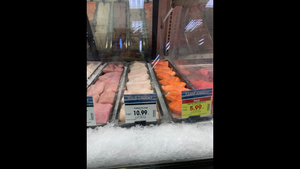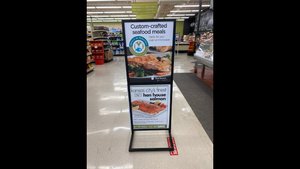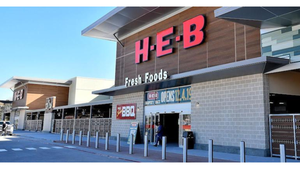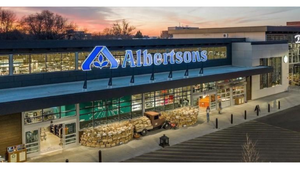A Tale of 3 Websites
Skogen's Festival Foods, ShopRite and Tops all have powerful, but tellingly different, information-gathering capabilities on their websites
February 21, 2011
MICHAEL GARRY
When Nick Arlt joined Skogen's Festival Foods, a 14-store chain based in Green Bay, Wis., nine years ago, as director of public relations, the traffic at the company's website, www.festfoods.com, was “next to nothing,” he said.

Select figure to enlarge.
These days, following years of improvements, the website draws hundreds of thousands of visitors and experiences millions of page views. In the past 2½ years, the growth of the site has been especially rapid, jumping from about 12 million annual page views to more than 28 million in 2010, said Arlt. According to Compete.com, festfoods.com attracted 71,794 unique visitors last month (5,128 per store), a 14% jump from a year ago.
“It's pretty amazing seeing the growth of the website,” said Arlt, who estimated that one-fourth to one-half of Skogen's shoppers are regular visitors, and up to three-quarters use it periodically.
On a comparative basis, Skogen's per-store monthly unique visitors put it at the high end of the grocery scale, according to Bill Bishop, chairman, Willard Bishop LLC, Barrington, Ill., who reported in 2009 that top-performing food retailers draw an average of 4,230 unique visitors per store per month, while typical food retailers bring in about 805.
Skogen's is a good example of a retailer that has been dedicated to developing its Web presence into a major extension of its in-store brand, especially with information on weekly specials, recipes, coupons and nutritional information that can be assembled into a comprehensive shopping list. Throughout the industry, food retailers are using their websites, in concert with social media and mobile phones, to build brand equity and earn the loyalty of shoppers who are increasingly digitized in their shopping habits.
The website “is pretty critical,” noted Arlt. “We're able to share ads, coupons and news about the company to the public. And it allows shoppers to directly contact us, and us to contact them.” Facebook, which is displayed prominently on Skogen's home page, helps to facilitate that communication with shoppers. Selling groceries online, however, remains a minor — though growing — piece of Skogen's Web strategy.
Grocery Shopping Network (GSN), Minneapolis, hosts a large part of Skogen's website and provides the functionality for interactive list building linked to the weekly circular, coupons and recipes, and for ecommerce. GSN, which has more than 90 retail customers, is one of three major grocery website service and hosting providers — MyWebGrocer and Webstop are the others — that hundreds of food retailers encompassing thousands of stores are using to offer interactive website features. Other retailers engaged with GSN include Giant Food Stores (Carlisle, Pa.), Hy-Vee, Save Mart, K-VA-T and Bi-Lo.
The website service providers are all able to weave the multiple strands of these websites into an integrated whole that makes it much simpler for shoppers to take advantage of capabilities like interactive list building — both online and increasingly on mobile phones. But the providers do differ in their approaches — differences that are reflected in a comparison of Skogen's website with that of ShopRite (hosted by MyWebGrocer) and Tops Friendly Markets (hosted by Webstop).
WEB-ONLY OFFERS
In the past, Skogen's website would “run alongside of our business,” with no special attention paid to it, Arlt said. But over the past two years, Skogen's has given the website a prominent spot in its newspaper circular, which points to such features as Internet-only offers (a “nice traffic builder,” said Arlt). In stores, everything from grocery bags to receipts highlights the website's URL, and more recently deli, meat and bakery labels and deli packaging have promoted the site.
Skogen's has taken great pains to make the site as user-friendly as possible. For example, first-time visitors are greeted by the floating image of a middle-aged male employee who explains the basic features and refers to an instructional video. “We deal with everybody in the grocery business, young, old, Internet-savvy and first-time users,” said Arlt. “We try to make it usable for everybody.” A webmaster oversees the technical aspects of the website and keeps it running smoothly.
The first decision a user of Skogen's site makes is to select one of its store locations. Each store-based version of the site features idiosyncrasies of its market, such as the paczki, a deep-fried dough dessert popular in the Polish neighborhoods of Green Bay, Wis., especially on Fat Tuesday (March 8). The customization allows Skogen's to promote events in individual markets.
Given Skogen's emphasis on its own coupons, many shoppers have gravitated to the website to find those offers as well as other store discounts and manufacturer coupons. “The biggest driver is the weekly ads and coupons area and within that the list-building function,” said Arlt. Across GSN's retail platforms, 60% to 70% of the traffic is for the online weekly circular, said Albin Andolshek, GSN's vice president of communications.
Skogen's does a “fabulous job” of attracting shoppers to its site, said Bishop of Willard Bishop LLC. “They make it clear that the website is the place to get high-value coupons by loading up values on the site.”
Skogen's shoppers have the option of registering at the website (and indicating nutritional preferences) but are not required to. Either way, they can click on any collection of discounts — the weekly circular ads, Internet-only offers, a “greensheet” of stock-up offers, a wine and spirits sheet, an HBC/GM sheet, store coupons, manufacturer coupons and other in-store specials — and add individual items to their shopping list. They can also call up recipes (from a collection of 60,000), shopping list favorites or just browse store aisles for all inventory, and add any of those items to the same list. Registered shoppers can retrieve shopping lists and recipes, as well as receive e-newsletters on sales.
To redeem online store and CPG coupons, shoppers print them along with their list and show them at the checkout. (Some of the items on a list are designated by store aisle.) “If they forget, we offer the coupons at the customer service center,” said Arlt. Skogen's, which does not run a loyalty card program, has no ability currently to electronically redeem online coupons, “but we are trying to find a way to do it,” he said.
Retailers partnering with GSN that employ a loyalty program can offer personalized online offers based on shopping history. Skogen's can't do that, although GSN is looking into leveraging the retailer's shopping list data to generate targeted online offers, said Andolshek. The lack of a loyalty card also makes it hard to correlate Web activity and in-store sales, though both are trending in a positive direction, said Arlt.
Skogen's also runs CPG ads on its site, including ads on printouts of lists and coupons. The retailer shares revenues from these ads with GSN; Arlt would not disclose the percentage split, or the cost of GSN services. Skogen's runs a modest ecommerce program in the Green Bay area, mostly as a service rather than as a revenue generator, with in-store pick-up and home delivery one day per week. As the economy improves, Arlt is seeing ecommerce sales improve, and he has observed a brisk and growing online business for gift cards.
Facebook has “taken off” over the past year for Skogen's and plays a significant role in the retailer's Web strategy, with more than 7,200 shoppers declaring that they “like” Skogen's, said Arlt. “It's a nice communication tool,” he noted. “People can ask us questions and we can answer them in a timely fashion.” During holidays such as Thanksgiving and Christmas, Skogen's queries shoppers on what foods they are preparing, sparking a free-flowing commentary. “It's a way for us to get ideas on what people are doing with our products,” he said.
When referencing sale items on Facebook, Skogen's focuses on signature fresh items and how they can be prepared, sometimes using videos. Bloggers, such as dietitians and company executives like Chief Executive Mark Skogen, also frequent the Facebook feed. Skogen's populates the social media venue with photos of special promotions, notably those featuring the Green Bay Packers throughout their Super Bowl run this year. Bishop is a proponent of putting pictures on a website to “personalize it” and make it “edgy.”
Like many retailers with an active Web presence, Skogen's is trying to extend its digital franchise to the mobile phone. Since November 2009, the retailer has employed text messaging to disseminate promotions, such as a contest to win roses for Valentine's Day. Skogen's tries to limit the frequency of text communications to once monthly for contests and two to three times per month for exclusive offers, which have generated �“great movement,” Arlt said.
Skogen's is also working with GSN on an app for iPhones and Android phones that is expected to be launched in the next few months. In addition to having circulars, lists and recipes, they want the app to include coupon redemption — a tricky mobile feature for food retailers — because it is so central to Skogen's marketing strategy.
The extension of product information from the store to the Internet to the mobile phone is creating a need for consistent data across all of these platforms so as not to confuse shoppers, noted Steve Cole, chief marketing officer for Gladson, Lisle, Ill., which supplies product images and data, including ingredient and nutritional information, to retailers such as Meijer and Safeway.
PERSONALIZED OFFERS
ShopRite, the primary banner for the independent retailers operating 232 stores that own the Keasbey, N.J-based Wakefern wholesale cooperative, uses MyWebGrocer, Colchester, Vt., to host its website and provide ecommerce and interactive list-building features. MyWebGrocer has about 100 retail customers, including Raley's, Winn-Dixie and Kroger, which recently began leveraging its online planning tools.

ShopRite allows shoppers on Facebook to “like” specific recipes and items.
ShopRite.com's list-building system is linked to its weekly circular (customized by store) and to its recipe database (with about 3,500 recipes), allowing shoppers to select items from those areas for the list. “Our weekly circular is the No. 1 reason that customers visit our site,” said Cheryl Williams, vice president of marketing for Wakefern. “Our online shopping list tool and online coupons are also very heavily viewed pages. Our customers are looking for savings and value.” CPG companies also advertise on the site, with MyWebGrocer and ShopRite sharing the revenue.
However, the list can't be populated with manufacturer coupon items. “We are currently exploring our options to provide this feature to our customers,” said Williams. On the other hand, manufacturer coupons, which are provided via Coupons.com and Cellfire, can be downloaded onto the shopper's loyalty card and electronically redeemed at the checkout — and don't have to be printed. Shoppers can also sign up for “YourBucks,” which sends personalized offers based on shopping history via either a cell phone or email, from which they can be downloaded to the loyalty card. “Customers appreciate these offers because they are getting value and savings for items they are interested in,” said Williams.
ShopRite has offered a weekly specials app on the iPhone for more than a year and on Android phones since last fall. It can also be accessed via m.shoprite.com. The app allows shoppers to create a list by typing in items as well as accessing promotions from a particular store's weekly circular, but they can't access recipes or coupons. The mobile list syncs with lists created on the website.
In November, ShopRite expanded its Facebook capabilities to enable shoppers to “like” particular items, recipes or circulars, sending them to their Facebook page for exposure to their friends, who can click on them to get onto ShopRite's site. Shoppers can also download a weekly-specials widget onto a number of sites such as Netvibes, Pageflakes and Bebo. This month ShopRite launched a blog section (blog.shoprite.com) called Potluck, which features about a dozen food and mom bloggers who write about store brands and recipes.
ShopRite promotes its website using traditional advertising (print ads, radio and TV), as well as digital media, such as email marketing, search optimization, social media and the blogger panel.
To promote the website in-store, ShopRite created POS material and shelf talkers “and even employ our grocery bags as a tool to drive traffic to our site,” said Williams.
According to Williams, the percentage of shoppers using the website and mobile apps continues to grow. “This year over last, our page views were up over 50% while our unique visitor count increased over 20%,” she said. According to Compete.com, ShopRite.com drew 587,251 unique visitors last month (2,531 per store), an increase of 31% over the previous year. In addition, the number of mobile app downloads has “far exceeded our expectations,” she said. “We thought mobile would be a great retention tool, but it turned out to be an amazing acquisition tool.”
ShopRite has an extensive ecommerce service, ShopRite from Home, with sales increasing almost 10% over the previous year at the 64 stores (servicing 84 locations) that offer it, Williams said. In 2011, ShopRite has so far opened six new locations that support online shopping.
SITE CONSOLIDATION
Tops Friendly Markets' current website came together last September after Tops was able to acquire most of what was left of the Penn Traffic chain, increasing its store count from 71 to 133. It was a challenge to merge Tops' original site with the acquired sites into a “seamless presentation,” said Terry Kushner, senior manager of interactive Web and consumer insights for Tops, based in Williamsville, N.Y.
Since the consolidation, unique visits to the website have increased by 50%, Kushner said. According to Compete.com, Topsmarkets.com brought in 111,868 unique visitors (841 per store) last month, a gain of 95% from the previous year.
Webstop, Palm Harbor, Fla., which had worked with the acquired sites, now hosts the consolidated www.topsmarkets.com, and provides interactive list-making functionality. Webstop works with 100 retailers encompassing about 1,000 stores, including Harps Food Stores, Price Chopper and independents served by Unified Grocers, Commerce, Calif., said Shawn Tuckett, director of business development for Webstop. The company recently signed an agreement with IGA to support the websites of 1,200 IGA retailers, he added.
Unlike the ShopRite and Skogen's sites, shoppers must register on the Tops site to access the list-making functionality, which is also tied to loyalty card information. They can populate the list with items from a weekly circular, many of which have links to recipes. Shoppers can also access a database of 5,000 recipes and grab items for their list. “We are a highly specials-driven supermarket,” said Kushner. “Giving customers access to information is very important.” Shoppers can also retrieve lists and create a personal recipe book. The site also explains Tops' recently adopted NuVal nutrition rating system.
Unlike the weekly circulars at ShopRite and Skogen's, Tops breaks out each item in the circular into a separate box alongside the circular page. Shoppers also have access on the website to coupons from SmartSource that can be printed out; Tops is currently investigating other sources of coupons, and is working on adding click-to-list functionality for coupons, said Kushner. Webstop is also working on a digital, paperless redemption program for online coupons, said Tuckett. The site doesn't run banner ads from CPG firms and does not have access to other in-store promotions such as temporary price reductions.
Tops' website invites shoppers to sign up for email “ad alerts,” enabling them to see the weekly ad on Saturday morning, a day early. On Valentine's Day, email recipients received an offer for a free cinnamon bun. In addition, Tops has developed a “YourBucks” program with Catalina Marketing. Shoppers are informed of personalized offers via mobile phone or email, and if they purchase the promoted product they receive at the POS a coupon for dollars off a subsequent trip.
Last week, Tops introduced a mobile Web app optimized for the iPhone, Android phones and the BlackBerry. The app effectively mimics — and syncs with — the list-making apparatus on the website, including the weekly ad and recipes. To access the app, shoppers have a link emailed to their phone.
As part of its foray into mobile marketing, Tops recently introduced QR codes on store signs and weekly ads that shoppers can capture with their mobile phone cameras; this accesses information on the Tops website on its “Monopoly” promotion, in which shoppers receive game tickets at the checkout for prizes. Tops also has a Facebook and Twitter presence to promote the Monopoly game and drive shoppers to the website.
About the Author
You May Also Like






